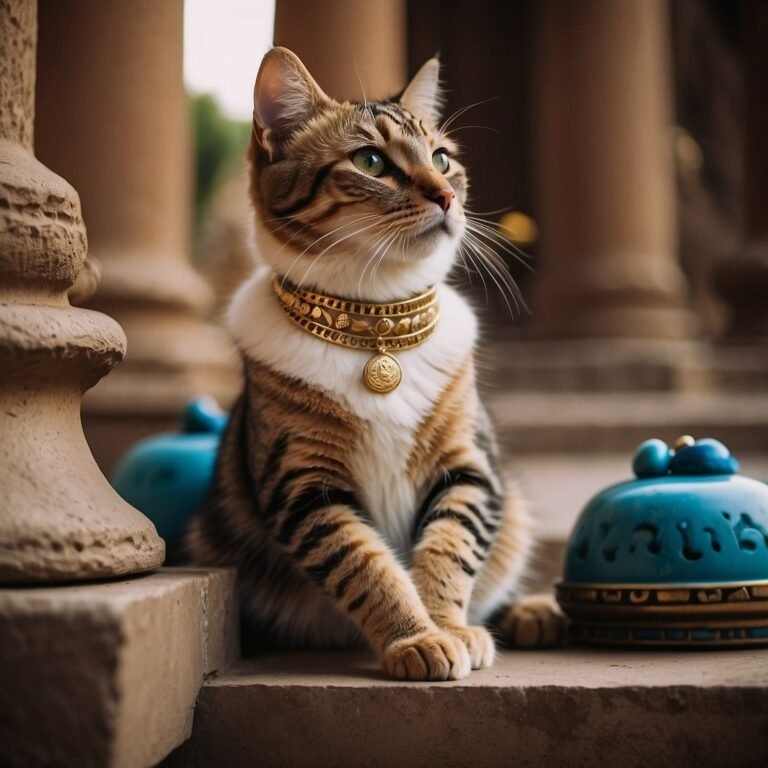Cats in Ancient Egyptian Society: Paws, Pyramids, and Preservation 🐱👤🏺

In ancient Egypt, your feline friends weren’t just pets; they were pawsitively revered! 🐾 It’s no myth that in your favorite Egyptian tales, cats held a special place in both homes and temples.
They lounged around the Nile and were considered sacred creatures, often associated with deities.
Imagine living in a society where your purring pal could be linked to the gods! Cats were a symbol of grace and poise and were thought to bring good fortune to those who housed them.

These whiskered beings were not only cherished companions but also represented powerful symbols in Egyptian society.
They slinked their way into the hearts of the Egyptians, earning a status that was both protective and divine.
A stroll down the sunbaked streets of Bubastis might have led you to extravagant temples dedicated to Bastet, the cat goddess, who was believed to embody fertility, womanhood, and protection. 🌞
And when it came to afterlife aspirations, your little lion wasn’t left behind.
Many cats were mummified and placed in tombs alongside their owners.
This practice underscored their importance in daily life and beyond.
The Egyptians believed that cats could bring their mystical powers into the afterlife, providing safety and guidance.
Isn’t it fascinating to think that your cat’s ancestors might have been part of such a purr-estigious ritual? 🐱✨
The Sacred Status of Cats in Egyptian Mythology
Did you know that in ancient Egyptian society, cats were revered to such an extent that they were often associated with gods and goddesses? Let’s dive into how these divine felines were worshipped and depicted in the rich tapestry of Egyptian mythology. 😺
Feline Deities and Their Roles
Cats were not just pets in ancient Egypt; they were seen as incarnations of the gods. Bastet, the goddess with the head of a lioness or a domestic cat, was the deity of home, fertility, and childbirth.
She was beloved by the Egyptians for her protective qualities, often portrayed holding a sistrum, a musical instrument that was believed to ward off evil spirits.
Sekhmet, another powerful deity, was depicted as a lioness and was known as the goddess of war and healing.
She wielded a deadly force but also had the ability to cure diseases.
Sekhmet was associated with the sun disk, representing the devastating heat of the sun.
You had to be brave to mess with these divine beings, considering they would stand guard and protect you – as long as you stayed on their good side! 😼
Symbols and Representation in Egyptian Art
Cats were ubiquitous in Egyptian art, symbolizing various mystic and everyday aspects of life.
Bastet, being associated with the act of war as well as joy, was often depicted with the sun disk atop her head.
This signified her dual nature as both a nurturing mother figure and a fierce protector of the pharaoh.
Sakhmet, the counterpart to the gentle Bastet, was often represented with a lioness’s head, signaling her strength and ferociousness.
Artworks typically showed her with a solar disk and the uraeus, highlighting her connection to royalty and divine authority.
These feline deities took center stage on many temple walls, amulets, and sculptures, showcasing their multifaceted roles in society and the cosmos.
Throughout your journey in ancient Egyptian art, you’ll constantly encounter these majestic feline deities, reminding you of their eternal watch over the land of the Nile. 🐾✨
Cats in the Daily Life of Egyptians
Cats were revered in ancient Egyptian society not only for their divine association but also for their practical roles in everyday life, making your ancestors’ day-to-day activities a little easier and more joyful.
Domestication and Companionship
In the warmth of Egyptian homes, domestic cats became much more than mere animals; they were cherished family members.
Egyptians embraced cats for their companionship, and it was common to see them living alongside humans, being nurtured as one of their own.
Paintings and sculptures from the era often depict these feline companions lying in laps or being fed, showing that the relationship between humans and cats was one of mutual affection and care.
Cats in Agriculture and Pest Control
When it came to agriculture, a pivotal part of Egyptian life, cats played a critical role in protecting granaries from rodents and birds.
Their natural hunting skills made them excellent at pest control, ensuring that the food supplies were safe from would-be scavengers.
The presence of a domesticated cat in crop storage areas meant fewer losses and a more bountiful harvest.
The Egyptians quickly recognized these furry allies as essential in maintaining the balance between nature and agriculture. 🐾
Art, Sculpture, and the Image of the Cat

If you’re a cat enthusiast, get ready to explore the exquisite portrayal of felines in ancient Egyptian society.
You’ll gain insights into how cats graced artworks and sculptures and what these depictions meant to a civilization that revered them.
Depictions of Cats in Ancient Egyptian Art
Ancient Egyptian art is renowned for its rich detail and symbolic representation, often featuring the majestic profiles of pharaohs and gods alongside the humble yet adored cat.
It’s in the intricate paintings within tombs where cats frequently appear, showcasing their importance in society – positioned as hunters or companions in scenes that depict daily life.
These paintings not just reflect their status but also demonstrate fashion trends, where cats are adorned with collars or jewels, indicating their cherished position.
Witness this celebration of felines through the cat goddess, Bastet, whose image could not just be seen in sculptures but inspired various forms of ancient Egyptian art.
Statues and Jewelry as Forms of Worship
Cats in ancient Egypt weren’t merely pets – they were divine.
The affection for cats translated into splendid statues and jewelry, becoming a medium for expressing reverence.
So if you love your cat a ‘pawt’ load, imagine crafting a sumptuous bronze sculpture or a piece of gold ornamentation in its likeness.
This is what Egyptians did, creating votive offerings and cat statues, some made of bronze and others, like the imposing figure of a cat with kittens from the Brooklyn Museum, which can definitely be considered a pinnacle of cat statues.
Explore the art of devotion where jewelry pieces might feature symbols of Bastet, signifying protection and good fortune, deeply woven into the culture’s fabric.
Discover these artifacts that have survived millennia, exemplifying Egyptians’ boundless adoration for cats.
Rituals of Adornment and Protection
You’ll find that in ancient Egypt, your feline friends weren’t just cute companions—they were revered symbols with spiritual significance, often adorned with amulets and included in funerary customs for their protective powers.
Amulets and the Protective Powers of Cats
🐱 Cats were regarded as the personification of protection.
Amulets bearing cat images or figures were commonly worn or placed in homes.
These weren’t just decorative; they were believed to channel the protective essence of the cat and influence divine forces. Bastet, the goddess with a feline head, was the ultimate protector deity, and her amulets were one of the most sought-after forms of spiritual safeguarding.
- Materials: Amulets were often made of gold, silver, or bronze.
- Usage: Worn daily or placed in strategic locations for ongoing protection.
Cats in Funerary Customs
In life as well as death, cats played a significant role.
Funerary customs often incorporated cats, seen as protectors of the deceased on their journey to the afterlife. Tomb paintings often depicted cats, sometimes at their owner’s feet, to ensure the owner’s safe passage and provide comfort.
Also, mummified cats served as funerary goods—a gift to the gods or as an eternal protector for the deceased.
- Position in Tombs: Often by the owner’s side or in a separate sarcophagus.
- Significance: Ensured the protection of the dead, serving as loyal guardians even in the afterlife.
Remember, cats weren’t just pets in ancient Egypt—they were divine protectors adorning life and death! 🐾
Mummification and Afterlife Beliefs
In ancient Egyptian culture, your furry companions were not just pets; they were also spiritual entities.
Mummified cats served a deeper, more sacred role, linking the physical world to the afterlife.
Process and Significance of Cat Mummification
🐱 The Egyptians undertook a meticulous process to preserve your cat for the journey beyond.
The mummification ritual involved desiccating the body with natron salts to eliminate moisture, thus averting decay.
Your feline friend would then be wrapped in linen, often accompanied by ornamental pieces and amulets to safeguard them on their passage.
The careful treatment of these feline mummies reflects their deemed importance, intertwining with beliefs in fertility and protection.
- Materials Used: Natron, linen, amulets
- Key Objectives: Preservation, protection, reverence
Cat Mummies and Their Roles in the Afterlife
Once immortalized through mummification, cats received a place in the afterlife alongside their owners.
Buried in coffins or special vessels, these mummified cats became symbols of grace in the hereafter, exemplified through tomb paintings and decorations.
They safeguarded against maleficent spirits and granted a serene passage to the other world.
The discovery of many such mummies in spots like Saqqara emphasizes their significance in bridging the living and the gods.
- Roles in Afterlife: Protection, companionship, spiritual symbolism
- Artistic Representation: Tomb paintings, tomb decorations
Your whiskered companions were much more than just pets in Ancient Egypt; they were integral and holy participants in life’s journey to the realm of eternity. 🐾

